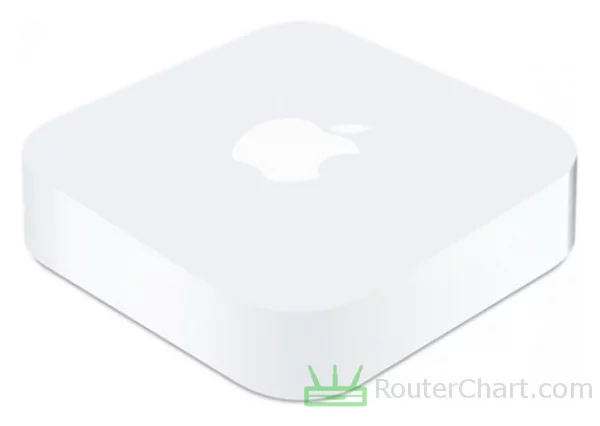Apple AirPort Express Base Station router review
Apple introduced the AirPort Express Base Station router in 2012. It is powered by Atheros AR9344 @ 533 MHz chipset, 64 MB of RAM, and 16 MB of flash memory.
Want to know if the Apple made a really good router? Stick around until the end of our article!
Table of Contents
- Apple AirPort Express Base Station specifications
- Body, dimensions, weight
- System, chipset, RAM, flash, power supply
- Network, protocols, WAN and LAN ports
- Wireless, antennas, speed, security
- Connectivity
- Administration, user interface, login information
- Links
- Verdict, Pros and Cons
- Photos
- Comparisons
Our personal experiences and opinions form the basis of this article. We aimed to share insights on a topic, and we hoped others would find it useful and inspirational. If you noticed any mistakes or missing details about the Apple AirPort Express Base Station, please let us know.

The AirPort Express Base Station supports Wi-Fi 5 (802.11ac) for faster wireless speeds. Apple routers are well-liked because of their user-friendly design.
Apple AirPort Express Base Station specifications
| Brand | Apple |
|---|---|
| Name | AirPort Express Base Station |
| Type | A1392 |
| Rating | |
| Launch | 2012 |
Body
| Dimensions | 98 x 98 x 23 mm |
|---|---|
| Weight | 240 g |
The dimensions of a router can impact its cooling capabilities. Larger routers have more room for internal cooling. The weight of the router is not typically a critical factor for most setups.

System
| Chipset | Atheros AR9344 @ 533 MHz |
|---|---|
| RAM | 64 MB |
| Flash | 16 MB |
| OS | Apple |
| Power supply | internal |
The Apple AirPort Express Base Station router has a Atheros AR9344 @ 533 MHz processor. You cannot expand the router's memory (64 MB). When selecting a router, it's essential to think about the RAM specifications.

Network
| Protocols | IPv4 |
|---|---|
| LAN ports | 1 x 10/100 Mbps |
| WAN ports | 1 x 10/100 Mbps |
| Mobile network | no |
| VPN support | no |
The WAN port on the AirPort Express Base Station router is a Fast Ethernet port, not a Gigabit Ethernet.

Wireless
| Antennas | 2 x 3 dBi internal |
|---|---|
| 2.4 GHz | yes |
| 5 GHz | yes |
| 60 GHz | no |
| Standards | IEEE 802.11a/b/g/n |
| Class | N600 |
| Speed | 300 + 300 Mbps |
| Transmit power | 15 dBm |
| Security | WEP WPA WPA2 |
| Guest network | no |
Many IoT devices, smart home devices, and older Wi-Fi devices mainly use the 2.4 GHz band. The 5 GHz band is less crowded, and the AirPort Express Base Station router is 5 GHz capable. Older routers have a more limited range than newer Wi-Fi standards. So, they're less suitable for larger homes or offices. The introduction of WPA2 (Wi-Fi Protected Access 2) improved upon WEP. It provides stronger security.
Connectivity
| USB ports | 1 x USB 2.0 |
|---|---|
| Print server | yes |
| File server | yes |
The USB 2 port has a maximum theoretical data transfer rate of 480 megabits per second (Mbps). USB print servers let you connect a USB printer to your network. You can connect external storage devices such as USB flash drives or USB hard drives to your router.
Administration
| Default IP | 10.0.1.1 |
|---|---|
| Default password | public |
Changing the default password improves your router's security. It reduces the risk of unauthorized individuals controlling your network.
Links
| Official site | https://www.apple.com/ |
|---|
Pros and Cons
Every router, including this Apple one, has its good sides and not-so-good sides. Let's take a closer look at both to get a full understanding of what this router can do. Just remember, this is just what I think, and you might see things differently.
Pros
- lightweight
- sufficient memory
- works on 5 GHz band
- USB 2 compatible
- printserver functionality
- fileserver operation
Cons
- insufficient flash
- lack of Gigabit LAN
- Non-gigabit WAN port
- missing Wi-Fi 6 support
- lacks Wi-Fi 5 compatibility
- reduced Wi-Fi bandwidth
- incompatible with WPA3
- missing WPS support
Apple AirPort Express Base Station photos




Apple AirPort Express Base Station comparisons
We've noticed that many of our visitors like to compare the Apple AirPort Express Base Station router with these popular models.
If there’s information about the Apple AirPort Express Base Station that you would like to see on this site, then write to us.
Updated: May 25, 2024


